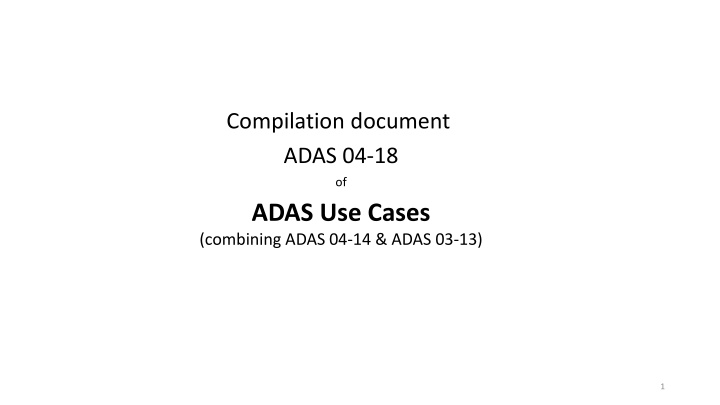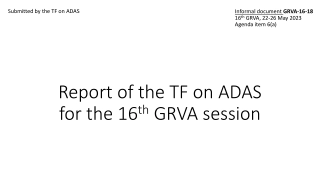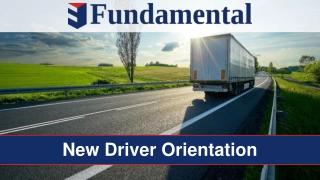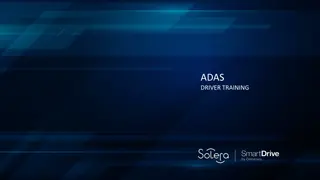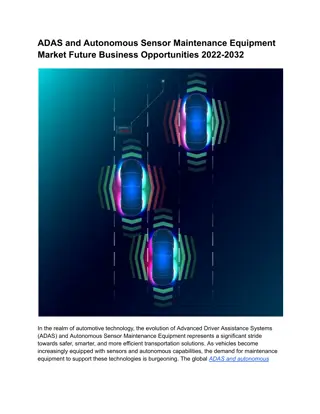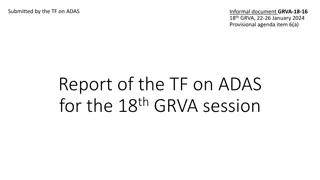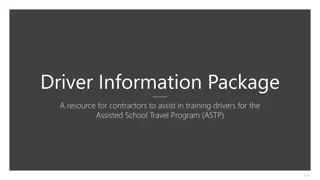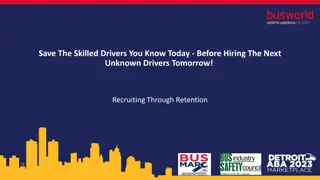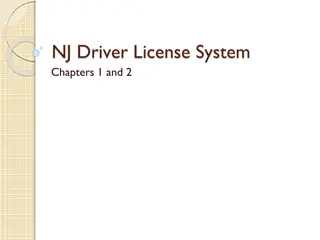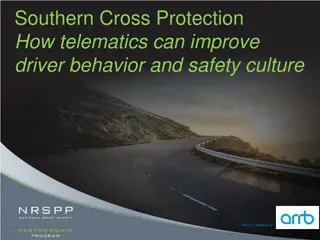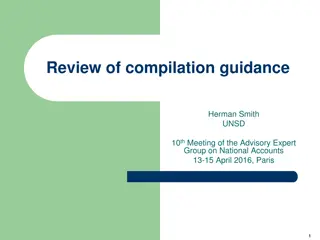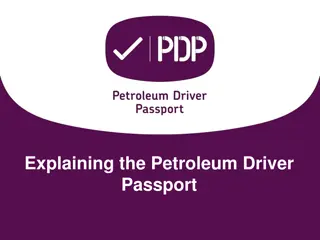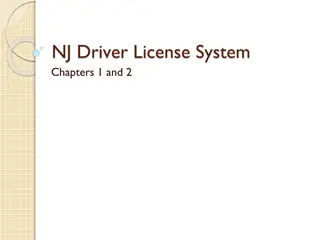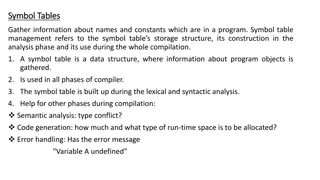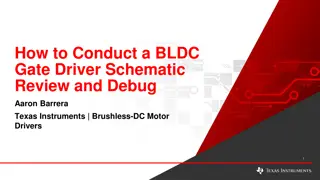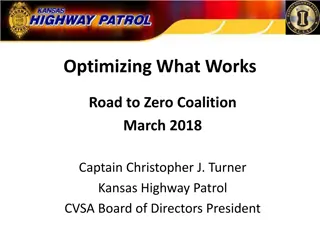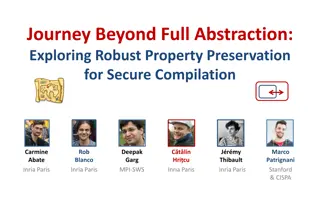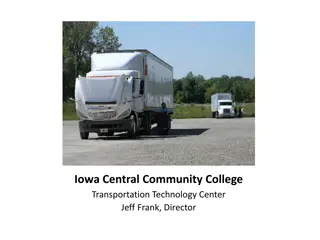Advanced Driver Assistance Systems (ADAS) Use Cases Compilation
Detailed use cases for ADAS systems assisting drivers in changing lanes, driving through roundabouts, and turning at intersections in urban and inter-urban environments. The scenarios include tasks, statistics, and general requirements to address each use case effectively, ensuring driver supervision and system support within specified speed limits.
Download Presentation

Please find below an Image/Link to download the presentation.
The content on the website is provided AS IS for your information and personal use only. It may not be sold, licensed, or shared on other websites without obtaining consent from the author.If you encounter any issues during the download, it is possible that the publisher has removed the file from their server.
You are allowed to download the files provided on this website for personal or commercial use, subject to the condition that they are used lawfully. All files are the property of their respective owners.
The content on the website is provided AS IS for your information and personal use only. It may not be sold, licensed, or shared on other websites without obtaining consent from the author.
E N D
Presentation Transcript
Compilation document ADAS 04-18 of ADAS Use Cases (combining ADAS 04-14 & ADAS 03-13) 1
Examples of a more detailed use case description Use Case Assisting changing lanes in a non-highway environment General Tasks (in that scenario, regardless of who (system/driver) performs them) Research/Data/Statistics Accidentology (DESTATIS 2019) Urban roads: 35 Fatalities, 1241 serious injuries, 11083 slight injuries Rural roads: 39 Fatalities, 743 serious injuries, 2916 slight injuries occur between vehicles moving parallel in the same direction. 4.4% of accidents with personal injuries. Identify need to change lanes Identify correct lane Identify availability of target lane Change into appropriate lane React to other road users Description Assisting the driver in performing a lane change in urban or inter-urban scenarios (e.g. changing from one lane to another at a fork/intersection) System identifies need to change lanes System identifies correct lane System initiates change into appropriate lane System reacts to other road users Driver initiates lane change System supports driver in changing lanes Max. system support Min. system support to assist the driver in changing into the correct lane. ODD Domain: Urban Inter-urban General Requirements to address this use case Speed: < [70]km/h Ensure driver supervises the vehicle behavior and environment Ensure vehicle behavior is predictable to the driver (e.g. informations and warnings) . Ensure vehicle behavior remains controllable by the driver. Ensure system has sufficient environmental perception/information Assumed driver supervision/involvement: Hands-on lateral control 2
Examples of a more detailed use case description General Tasks (in that scenario, regardless of who (system/driver) performs them) Use Case Assisting Driving through roundabouts Research/Data/Statistics Accidentology (DESTATIS 2019) Urban roads: 6 Fatalities, 566 serious injuries, 4627 slight injuries Rural roads: 8 Fatalities, 236 serious injuries, 1349 slight injuries occur at roundabouts. 2% of accidents with personal injuries. Approach roundabout at appropriate speed Yield to other road users before/when entering/exiting the roundabout Drive through the roundabout Take the right exit Description Assisting the driver in driving through a roundabout System adapts vehicle speed to lane geometry and other road users System plans appropriate trajectory and provides corresponding steering support System supports driver before and after roundabout Max. system support Min. system support ODD Domain: Urban Inter-urban to assist the driver in driving through the roundabout. Speed: < [70]km/h General Requirements to address this use case Ensure driver supervises the vehicle behavior and environment Ensure vehicle behavior is predictable to the driver. Ensure vehicle behavior remains controllable by the driver. Ensure system has sufficient environmental perception/information Assumed driver supervision/involvement: Hands-on lateral control 3
Examples of a more detailed use case description General Tasks (in that scenario, regardless of who (system/driver) performs them) Use Case Assisting Turning at an intersection Research/Data/Statistics Accidentology (DESTATIS 2019) Urban roads: 155 Fatalities, 6973 serious injuries, 46392 slight injuries Rural roads: 121 Fatalities, 4393 serious injuries, 18601 slight injuries occur when turning into road. 20% of accidents with personal injuries. Approach the intersection at an appropriate speed Yield to other road users in the intersection if necessary (right of way by traffic lights?) Make the necessary turn Description Assisting the driver in turning at an intersection Specifics: With/without traffic lights System adapts vehicle speed when approaching the intersection System stops at traffic lights if necessary System plans appropriate trajectory and provides corresponding steering support System supports the driver in steering the vehicle through the intersection Max. system support Min. system support ODD Domain: Urban Inter-urban to assist the driver in making the necessary turn General Requirements to address this use case Speed: < [70]km/h Ensure driver supervises the vehicle behavior and environment Ensure vehicle behavior is predictable to the driver. Ensure vehicle behavior remains controllable by the driver. Ensure system has sufficient environmental perception/information Assumed driver supervision/involvement: Hands-on lateral control 4
Examples of a more detailed use case description General Tasks (in that scenario, regardless of who (system/driver) performs them) Use Case Forming an emergency corridor Research/Data/Statistics No accident data available in DESTATIS/GIDAS Assessing the situation, where the corridor shall be built Swerving to the corresponding side of the ego lane Checking lateral distance to lane boundaries or other vehicles When necessary: crossing lane markings to gather additional space Description Assisting the driver in the formation of a corridor for emergency vehicles at low speed Specifics: With/without crossing of lane markings System delivers steering support in the right direction to remind driver to form a corridor, when falling below a certain speed System warns driver to be aware of objects in the adjacent lane / road edge System keeps a certain minimal lateral distance to the detected objects / boundaries System delivers steering support in the right direction to remind driver to form a corridor, when falling below a certain speed Max. system support Min. system support ODD Domain: Highway Multilane roads without risk of oncoming traffic General Requirements to address this use case Speed: < [30]km/h Ensure driver supervises the vehicle behavior and environment Ensure vehicle behavior is predictable to the driver. Ensure vehicle behavior remains controllable by the driver. Ensure system has sufficient environmental perception/information Assumed driver supervision/involvement: Hands-on lateral control 5
Examples of a more detailed use case description General Tasks (in that scenario, regardless of who (system/driver) performs them) Use Case Changing Lanes, initiated by the system Research/Data/Statistics Accidentology (GIDAS*, ego run-up in right lane) Highway: 1530 accidents with injuries Other: 2057 accidents with injuries Identify the need to change lane Identify the availability of an appropriate target lane Indicate the planned manoeuvre to other road users Change into target lane React to other road users Control lateral and longitudinal movement Description Assists the driver in performing lane changes when deemed reasonable occur when running-up on vehicles. ~1,2% of accidents with injuries * GIDAS 2020_2 extrapolated to Germany, DESTATIS 2019 System identifies the need for a lane change System identifies availability of target lane System informs the driver on the intention and execution to change the lane System changes the lane automatically System controls lateral and longitudinal movement of the vehicle on a sustained basis System identifies the need for a Lane change System suggests a lane change to the driver and waits for a dedicated confirmation System controls lateral and optional the longitudinal movement Max. system support Min. system support ODD Domain: Highway Multilane roads without oncoming traffic General Requirements to address this use case Speed: No restriction Ensure driver supervises the vehicle behavior and environment Ensure vehicle behavior is predictable to the driver (e.g. information's and warnings) . Ensure vehicle behavior remains controllable by the driver. Ensure system has sufficient environmental perception/information Assumed driver supervision/involvement: Hands-on lateral control 6
Examples of a more detailed use case description General Tasks (in that scenario, regardless of who (system/driver) performs them) Use Case Changing Lanes, initiated by the system Research/Data/Statistics Accidentology (GIDAS*, ego rear-end in left/middle lane after lane change) Highway: 787 accidents with injuries Other: 371 accidents with injuries Identify the need to change lane Identify the availability of an appropriate target lane Indicate the planned manoeuvre to other road users Change into target lane React to other road users Control lateral and longitudinal movement Description Assists the driver in performing lane changes when deemed reasonable occur when being rear-ended after lane change to the left. <0,5% of accidents with injuries * GIDAS 2020_2 extrapolated to Germany, DESTATIS 2019 System identifies the need for a lane change System identifies availability of target lane System informs the driver on the intention and execution to change the lane System changes the lane automatically System controls lateral and longitudinal movement of the vehicle on a sustained basis System identifies the need for a Lane change System suggests a lane change to the driver and waits for a dedicated confirmation System controls lateral and optional the longitudinal movement Max. system support Min. system support ODD Domain: Highway Multilane roads without oncoming traffic General Requirements to address this use case Speed: No restriction Ensure driver supervises the vehicle behavior and environment Ensure vehicle behavior is predictable to the driver (e.g. information's and warnings) . Ensure vehicle behavior remains controllable by the driver. Ensure system has sufficient environmental perception/information Assumed driver supervision/involvement: Hands-on lateral control 7
Examples of a more detailed use case description General Tasks (in that scenario, regardless of who (system/driver) performs them) Use Case Driving around obstacles being in the driving lane Research/Data/Statistics Accidentology (GIDAS*) Urban: 2367 accidents with injuries Rural: 493 accidents with injuries occur when driving into obstacles in the driving path. ~1% of accidents with injuries. Identify, if ego lane is blocked by an obstacle Identify availability of target lane If target lane is not available, slow down and wait Steer into the target lane to drive around the obstacle Keep a safe lateral distance to other road users and infrastructure e.g. parked vehicles Description Assisting the driver in following a driving path around obstacles, which are blocking the current driving lane. (this is not an emergency situation) * GIDAS 2020_2 extrapolated to Germany, DESTATIS 2019 System supports the driver in following the required driving path by identifying an appropriate trajectory, taking surrounding traffic into account. System supports the driver in following the required driving path by identifying an appropriate trajectory only on roads where there is traffic moving in the same direction in the adjacent lane, taking traffic from behind into account. Max. system support Specifics: the adjacent lane may used by traffic moving in the same or in the oncoming direction Min. system support ODD Domain: Urban Interurban General Requirements to address this use case Speed: Usually in urban scenarios <[50]km/h In inter-urban environments < [100]km/h Ensure driver supervises the vehicle behavior and environment Ensure vehicle behavior is predictable to the driver. Ensure vehicle behavior remains controllable by the driver. Ensure system has sufficient environmental perception/information Assumed driver supervision/involvement: Hands-on lateral control 8
Examples of a more detailed use case description Use Case Find a space nearby and park General Tasks (in that scenario, regardless of who (system/driver) performs them) Search, navigate environment and identify an appropriate parking space on current/nearby roads (implementation-dependend) (currently not in ACSF A) Detect nearby vehicles and VRUs Appropriately indicate and perform the rearward or frontward parking manoeuvre (similar to ACSF A) Description The vehicle assists the driver in finding a parking space in nearby roads and parks, the driver is in the vehicle System navigates environment to find a spot System adapts vehicle speed and stops, preparing for parking manoeuvre System externally indicates manoeuvre intent System detects and yields for VRUs/vehicles if required System plans appropriate trajectory and provides corresponding steering support to park the vehicle (rearward or forward) System supports the driver in finding a parking space System assists in steering System detects for VRUs/vehicles Driver confirms the parking manoeuvre once appropriate space is identified (i.e. use of indicator stalk/indicators) Max. system support Min. system support Specifics: Navigating nearby roads/parking area With/without confirmation when space is identified Roads versus parking areas Lane markings ODD Domain: Urban Inter-urban Private General Requirements to address this use case Ensure driver supervises the vehicle behavior and environment Ensure vehicle behavior is predictable to the driver and appropriate information is provided Ensure vehicle behavior remains controllable by the driver Ensure system has sufficient environmental perception/information Speed: < [50-60]km/h (applicable speed limits), <[10]km/h during or close to parking (ACSF A) Assumed driver supervision/involvement: Hands-on lateral control 9
Examples of a more detailed use case description Use Case Extended valet/RCP General Tasks (in that scenario, regardless of who (system/driver) performs them) Search and identify an appropriate parking space Drive to target or driver s position, appropriately indicate intent to environment Detect nearby vehicles, VRUs & objects, yield/stop/avoid where appropriate Provide information to driver about intent, detection and manoeuvring through an external device Description The vehicle is commanded to find a parking space/comes to the driver from its parked position System adapts vehicle speed and performs parking manoeuvre appropiately System externally indicates manoeuvre intent System detects and yields for VRUs/vehicles if required System plans appropriate trajectory and manoeuvres using longitudinal & lateral control System parks or departs from parked position but halts shortly after Closer proximity of driver required Max. system support Min. system support Specifics: Deadman s switch required Information about vehicle s intent & environment provided on driver s external device Constant connection required ODD Domain: Parking lots General Requirements to address this use case Ensure driver is informed and aware of vehicle intent and manoeuvring, detection of objects and VRUs through external device (f.i. camera views, sensor fusion information, map, etc.) Urge driver to supervise the vehicle behavior and environment Ensure vehicle behavior remains controllable by the driver (limited to deadman s switch) Ensure vehicle behavior is predictable to the driver and surrounding traffic Ensure system has sufficient environmental perception/information Speed: < [10]km/h Assumed driver supervision/involvement: Hands-on lateral control 10
